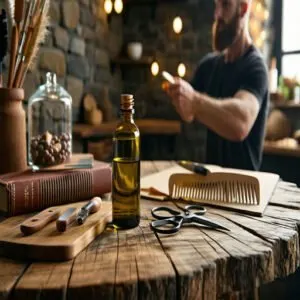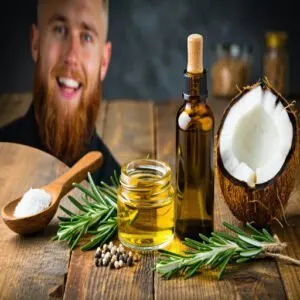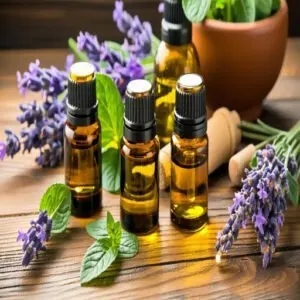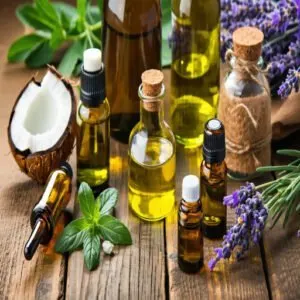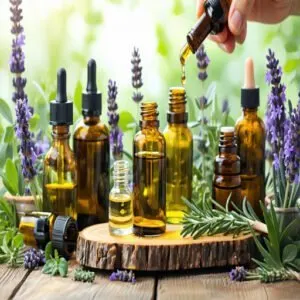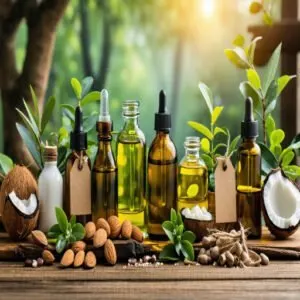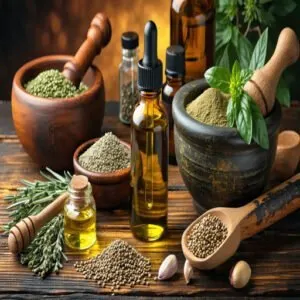This site is supported by our readers. We may earn a commission, at no cost to you, if you purchase through links.
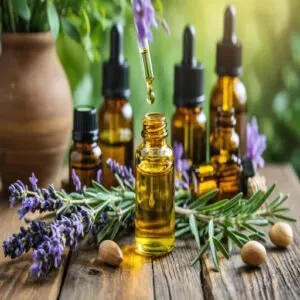
Start with a carrier oil like jojoba or argan (about 1 ounce) to keep your beard soft and skin itch-free.
Add 3-5 drops of essential oils like tea tree for its antibacterial perks or lavender for a soothing vibe.
Blend them in a small dropper bottle, give it a good shake, and voilà!
Store it somewhere cool and remember, a few drops daily will tame that beard like a pro.
Bonus tip: Experiment with scents to match your mood!
Table Of Contents
- Key Takeaways
- Beard Oil Basics
- Choosing Carrier Oils
- Essential Oil Selection
- Mixing Beard Oil
- Applying Beard Oil
- DIY Beard Oil Recipes
- Frequently Asked Questions (FAQs)
- Can You Make your own beard oil?
- What is a DIY Beard oil recipe?
- How do you make live bearded oil?
- Can I make a 2 oz bottle of Beard oil?
- How do you make a sweet mint Beard oil?
- How can I make beard oil at home?
- What is the most important ingredient in beard oil?
- What is the best oil to make beard oil?
- What are the best natural ingredients for beard growth?
- What are common mistakes when making beard oil?
- Conclusion
Key Takeaways
- Start with a carrier oil like jojoba or argan to keep your beard soft and skin itch-free, and then blend in 10 drops of essential oil per ounce for scent and added benefits.
- Essential oils like tea tree fight dandruff and irritation, while lavender or peppermint add soothing or refreshing effects—pick what suits your beard best.
- Use amber glass bottles to store your beard oil safely; they block UV light and keep the oil fresh longer.
- Apply a few drops daily on clean, damp skin, massage it thoroughly, and comb through for even distribution and a polished look.
Beard Oil Basics
Beard oil is a simple blend of natural oils that keeps your beard soft, healthy, and itch-free.
It’s all about using the right mix of carrier and essential oils to moisturize your skin and tame unruly hair.
What is Beard Oil
Beard oil is like a magic potion for your beard.
It’s a mix of natural beard oil ingredients that moisturize skin, soften hair, and boost beard growth.
Think of it as Beard Care 101—it tames wild hairs, keeps Skin Health in check, and adds a subtle shine.
Perfect for DIY beard oil or following a beard oil recipe!
Benefits of Beard Oil
Think of beard oil as the secret weapon for a healthier, shinier beard.
It tackles dryness and helps give your beard a softer, more manageable feel.
Plus, it’s a lifesaver for itch prevention and keeping skin happy underneath.
Essential oils can improve beard health and growth according to this helpful beard care guide.
- Fights dandruff, so your shirt stays flake-free.
- Keeps hair soft and kissable.
- Boosts beard shine and growth.
- Nourishes skin health naturally.
Importance of Carrier Oils
When crafting a homemade beard oil recipe, carrier oils are the backbone.
These oils, like jojoba or argan, offer skin benefits, nourish hair growth, and guarantee smooth oil absorption rates.
They soften coarse hairs and lock in moisture.
For a more detailed examination into their benefits, explore this informative guide on carrier oil recipes.
Mixing carrier oils adds versatility, boosts shelf life, and enhances your DIY beard oil.
Choose wisely—your beard will thank you!
Choosing Carrier Oils
Choosing the right carrier oils is the first step to making a great beard oil that works for your skin and hair.
Each oil offers something unique, so it’s important to know what suits your needs best.
Jojoba Oil Benefits
Jojoba oil’s no joke—it’s a rockstar among beard oil ingredients.
This liquid gold balances skin moisture, tames dryness, and speeds up hair growth.
It mimics natural oil absorption, keeping skin and scalp health in check without clogging pores.
You can explore various jojoba beard oil products for enhancing your beard care routine.
Great for beard softening too, making it a must-have in any homemade beard oil recipe.
The jojoba oil benefits? Pure magic.
Coconut Oil Uses
Regarding coconut oil benefits, this ingredient’s a game-changer for DIY beard oil.
It moisturizes skin, fights itch, and boosts hair growth while taming frizz.
Coconut oil’s antimicrobial properties also fight beard dandruff, keeping your facial hair healthy.
Perfect for homemade beard oil recipes, its versatility shines in oil blending.
You can learn more about coconut oil for beard growth.
- Hydrates skin to prevent beard dandruff.
- Softens hair, adding a healthy shine.
- Stimulates hair growth naturally.
- Soothes itch, leaving skin calm and nourished.
Essential Oil Selection
Choosing the right essential oil is key to creating a beard oil that smells great and provides real benefits.
From soothing lavender to invigorating peppermint, each oil offers something unique for your skin and beard.
Tea Tree Oil Benefits
Tea tree oil is your go-to for tackling beard troubles.
Its antibacterial properties and skin healing effects keep irritation and dandruff in check, while supporting hair growth.
Use this powerhouse in your oil blends for a tidy, itch-free beard.
Considering its use in tea tree oil treatments can also provide insights into its benefits for skin health.
Check out the table below for quick tips:
| Benefit | Why It Matters | Tip for Use |
|---|---|---|
| Antibacterial | Fights dandruff | Add 3 drops/oz oil |
| Skin healing | Soothes dryness | Apply post-shower |
| Hair growth | Fuller beard | Massage evenly |
| Natural remedy | Safe & effective | Dilute if sensitive |
| Multi-use | Versatile tool | Mix with lavender |
Lavender Oil Uses
Lavender essential oil packs a punch for any homemade beard oil recipe.
Its calming properties, from legendary aromatherapy effects, soothe your senses while keeping your beard smooth.
Tackling flyaways? A few drops tame stray hairs and add shine.
Bonus points: lavender skin perks like acne-busting and hair growth support.
Mix it up with jojoba for unbeatable beard oil benefits!
Peppermint Oil Effects
Looking for a beard refresh with a minty kick? Peppermint essential oil is your go-to.
Its cooling effect soothes itch, tames dandruff, and balances oily skin.
Plus, it ramps up blood flow, boosting hair growth.
Add a few drops to your homemade beard oil recipe for unbeatable beard oil benefits.
This powerhouse ingredient keeps your beard and skin minty fresh and healthy!
Mixing Beard Oil
When mixing your beard oil, start by measuring out your carrier oils and adding a few drops of essential oils to suit your style.
Shake it up well to blend everything, and you’re all set to enjoy your custom creation!
Dilution Recipes
Dialing in your beard oil recipe is all about proper Oil Ratios.
Stick to a 2% dilution—10 drops of essential oils per ounce of carrier oils beard—perfect for safety and balance.
Keep those Blend Techniques in check, and always follow Safety Precautions to avoid irritation.
Measurement Tips? Use droppers for accuracy.
That’s how DIY beard oil stays spot on! Understanding the correct beard oil dilution is essential for achieving the desired beard care results.
Adding Essential Oils
After setting up your base oils, the fun begins: adding essential oils.
Match your vibe with scent combinations like lavender essential oil for calm or rosemary essential oil for freshness.
Keep those oil potency levels balanced—roughly 10 drops of essential oils per ounce of carrier works best.
Experiment with essential oil blends to nail your perfect fragrance profile.
Understanding beard oil essentials is vital for creating effective homemade beard oil recipes.
Blending Carrier Oils
Now that you’ve nailed your essential oils, it’s time to perfect your carrier oil mix.
A solid beard oil blend starts with experimenting.
Try these ratios:
- 50% Jojoba, 50% Sweet Almond: Balanced and light.
- 70% Argan, 30% Grapeseed: Hydrating and quick-absorbing.
- 60% Coconut, 40% Avocado: Rich and soothing.
- 80% Jojoba, 20% Hemp Seed: Great for sensitive skin.
- Equal parts Hazelnut, Almond: Silky yet non-greasy.
Applying Beard Oil
Applying beard oil is simple, but doing it right makes all the difference.
With just a few drops and the right technique, you’ll keep your beard healthy, soft, and looking its best.
How to Apply Beard Oil
Start with clean skin, ideally after a shower, when pores are open for better oil absorption.
Rub 3-6 drops (adjust Beard Oil Dosage for Beard Length) into your palms, warming it up, then massage downward into your beard and onto dry skin.
Homemade beard oil works wonders for skin preparation while keeping it soft.
Understanding beard oil benefits is essential for a healthy beard care routine.
Here’s a quick guide:
| Beard Length | Oil Amount | Key Focus |
|---|---|---|
| Stubble | 3 drops | Skin hydration |
| Medium beard | 4-5 drops | Even distribution |
| Long beard | 6+ drops | Deep moisturization |
Tips for Even Distribution
When you’re applying homemade beard oil, don’t just splash and dash—make it count.
Use 3-5 drops for short beards, more for longer ones, and warm it in your hands.
Massage it evenly, reaching the skin, to ensure Even Coating and proper Hair Texturing for a polished look.
Follow up with Beard Combing or brushing to spread the oil.
DIY Beard Oil Recipes
You don’t need fancy store-bought products to keep your beard looking its best.
With just a few simple ingredients, you can whip up your own custom beard oil at home that’s perfect for your style and needs.
Simple Recipe Guide
Got 60 seconds? Here’s a quick DIY beard oil recipe!
Measure 1 oz of carrier oil (like jojoba) in a sterilized amber bottle.
Add 10 drops of your favorite essential oil for fragrance options—peppermint’s bold, lavender’s calming.
Shake gently, and you’re done.
This simple beard oil recipe keeps your beard soft and your beard care routine stress-free. Boom!
Customizing Your Recipe
Creating a custom beard oil recipe is like crafting your signature scent and care routine.
To nail it:
- Experiment with Oil Ratio Tips (e.g., jojoba for hydration, almond for softness).
- Try Fragrance Options like sandalwood or citrus.
- Match oils to your Skin Type (avoid heavy oils for oily skin).
- Prioritize Ingredient Safety—always patch test blends.
When creating your custom recipe, understanding beard oil benefits is essential for a healthy and soft beard.
Storing Homemade Beard Oil
Keep your homemade beard oil fresh with these quick tips.
Use amber glass bottles to block UV, and always sterilize them first (bottle sanitizing matters).
Label with the date and ingredients—trust me, it’s a lifesaver later.
Store in a cool spot, away from heat.
For warmer climates, refrigerate it to extend the beard oil shelf life.
The following tips are crucial for maintaining your beard oil’s quality and prolonging its shelf life.
| Tip | Why It Matters | Practical Action |
|---|---|---|
| Amber Glass Bottle | Blocks UV light | Transfer oil to dark glass bottles |
| Date Labeling | Tracks freshness and recipe | Write date and ingredients on label |
| Refrigeration Option | Prolongs oil’s shelf life | Store in the fridge (if hot climate) |
By following these quick tips, you can ensure your homemade beard oil remains fresh and effective for a longer period.
Frequently Asked Questions (FAQs)
Can You Make your own beard oil?
Making your own beard oil is a game-changer—like giving your beard a personal spa day.
Mix carrier oils like jojoba with essential oils, customize scents, and save cash while avoiding unnecessary chemicals.
Easy, right?
What is a DIY Beard oil recipe?
Mix 1 oz jojoba oil, 5 drops cedarwood oil, and 5 drops sandalwood oil in an amber glass bottle. Shake it well, and boom—you’ve got a nourishing, earthy DIY beard oil.
How do you make live bearded oil?
Did you know 63% of bearded men report healthier skin with oils.
For live beard oil, mix jojoba, argan, and a few drops of cedarwood and sandalwood essential oils.
Shake well, apply post-shower.
Can I make a 2 oz bottle of Beard oil?
Absolutely, you can!
Just double the recipe to fill a 2 oz bottle.
Use around 2 oz of carrier oils and add 20 drops of essential oils.
Shake well, and you’re good to go!
How do you make a sweet mint Beard oil?
Tired of boring beard oil?
Mix 2 tablespoons jojoba oil, 2 tablespoons sweet almond oil, and 6 drops peppermint essential oil.
Add 4 drops vanilla essential oil for sweetness.
Shake well, apply, and enjoy minty magic!
How can I make beard oil at home?
Grab a carrier oil like jojoba or argan.
Add 10 drops of your favorite essential oil (peppermint or cedarwood work great) per ounce, mix well.
Store in a small, dark glass bottle.
What is the most important ingredient in beard oil?
You might think it’s the scent, but the backbone of any beard oil is the carrier oil.
It hydrates, nourishes, and softens, keeping your beard and skin healthy, smooth, and itch-free.
What is the best oil to make beard oil?
You’ll want to grab jojoba oil—it’s a superstar for beard oil.
It mimics your skin’s natural oils, absorbs fast, and won’t clog pores.
Combine it with argan oil for extra nourishment and moisture.
Boom, perfect base!
What are the best natural ingredients for beard growth?
Did you know massaging oils like castor, coconut, or argan can boost beard growth naturally?
They improve circulation, nourish follicles, and hydrate skin.
Add peppermint or rosemary oil for extra growth power!
Simple and effective.
What are common mistakes when making beard oil?
Skipping carrier oil research? Big mistake—it could clog pores or irritate skin.
Adding too much essential oil burns, not benefits.
Ignoring storage tips? Expect spoiled oil fast.
Always test blends beforehand to dodge disasters!
Conclusion
Ready to rock a soft, stunning beard?
Crafting your own homemade beard oil recipe is super simple and endlessly satisfying.
Just pick your favorite carrier oils, like jojoba or argan, toss in essential oils for benefits and scent, then mix it up in minutes.
A few drops daily transform your beard, taming flyaways and nourishing your skin.
Experiment, tweak, and make it yours—because your beard deserves the best care, without breaking the bank!


